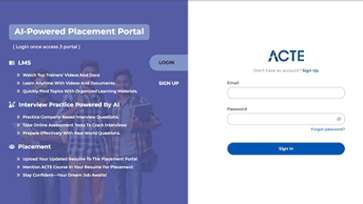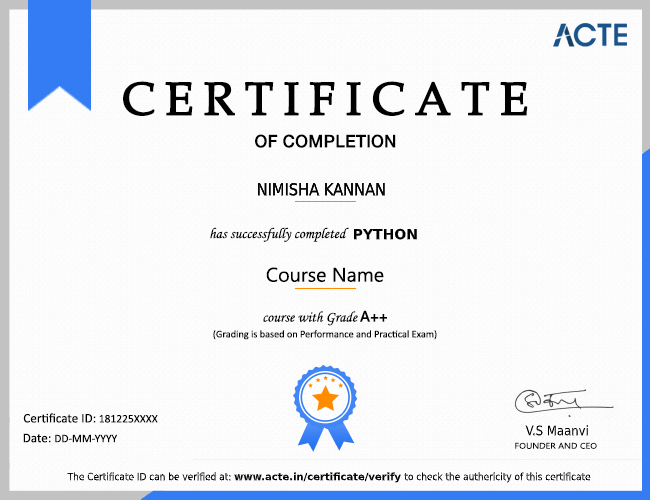Learn Hadoop, Hadoop Administrator, Hadoop testing courses with Hadoop's for real-world training and investment and substantial employment support for you to become a Hadoop Architect. Fullest online Hadoop Training including HDFS, YARN, MapReduce, Hive, Pig, HBase, Spark, Oozie, Sqoop, and Flume. Attend this training course for Hadoop certification at our classroom or online training for the instructor. The Hadoop Course in Indore is an intensive training program that will familiarise you with Hadoop Distributed File System, Hadoop Clusters, Hadoop MapReduce, and our expert big data professionals' Big Data Processing Ecosystem. In addition, this Big Data Training allows you to gain evidence of the important tools that are highly-awaited in the big data area, such as PIG, HDFS, Pig, Apache Hive, Java, Apache Spark, Flume, and Sqoop.
Additional Info
Big data refers to enormous collections of data that are too complicated and vast for people or standard data management methods to understand. These massive amounts of data, when correctly evaluated using contemporary tools, provide organizations with the information they need to make educated decisions. Big data sets may now be used and tracked thanks to recent software advances. To the human eye, most of this user data would appear useless and disconnected. Big data analysis tools, on the other hand, can trace the links between hundreds of different types and sources of data to provide relevant business insight.
The 3 V's are three defining qualities of all large data sets :
Volume : Millions of unstructured, low-density data points must be included in big data sets. Big data companies can store anything from a few terabytes to hundreds of petabytes of customer data. Companies now have access to zettabytes of data thanks to cloud computing! Regardless of apparent importance, all data is preserved.Big data experts say that unexpected data might sometimes hold the answers to business issues.
Velocity refers to the rapid creation and use of large amounts of data. To give the most up-to-date insights, big data is received, processed, and interpreted in rapid succession. Many big data platforms can even capture and analyze data in real-time.
Variety : Within the same unstructured database, big data sets contain many sorts of data. Traditional data management systems rely on structured relational databases that include certain data kinds that are linked to other data types in predefined ways. To identify all relationships between all forms of data, big data analytics algorithms employ a variety of unstructured data sources. Big data methods frequently result in a more comprehensive picture of how each aspect interacts.
Hadoop is a distributed data processing framework for storing and analyzing large volumes of data that is dependable, distributed, and scalable. Hadoop allows you to link several computers into a network for storing and processing large datasets.
Hadoop's appeal stems from its ability to run on low-cost commodity hardware, whereas its competitors may require more costly gear to accomplish the same task. It's also free and open-source. Hadoop has made Big Data solutions accessible to individuals outside of the IT industry and has made Big Data solutions inexpensive for everyday companies. Hadoop is frequently used as a catch-all phrase for the whole Apache data science environment.
Why to choose Big Data & Hadoop?
Hadoop is the greatest option for storing and processing massive data because Hadoop saves huge files as-is (raw) without any schema specification. High scalability - We can scale up to an unlimited number of nodes, greatly improving performance. Hadoop data is extremely accessible, even if the hardware fails.
- Hadoop as a Big Data Technology Gateway :
For Big Data analytics, Apache Hadoop is a cost-effective and dependable solution. Many businesses have embraced it. It is a full ecology, not just a single word. Apache Hadoop offers a huge ecosystem that caters to a variety of businesses. Hadoop was required by every firm, from digital start-ups to large corporations, to meet their business demands. Many components make up the Hadoop ecosystem, including HBase, Hive, Zookeeper, MapReduce, and so on. These Hadoop ecosystem components apply to a wide range of applications. Apache Hadoop will remain the backbone of the Big Data world, regardless of how many new technologies come and go. It serves as a point of entry for all Big Data technologies.To advance in the Big Data world, one must understand Hadoop and grasp other big data technologies that are part of the Hadoop ecosystem.
- As a Disruptive Technology, Hadoop :
In terms of dependability, scalability, affordability, performance, and storage, Hadoop is a good alternative to traditional data warehousing solutions. It has transformed data processing and ushered in a sea change in data analytics. In addition, the Hadoop ecosystem is always being improved and experimented with. Big Data and Apache Hadoop are taking the globe by storm, and we must ride with the wave if we do not want to be affected.
Roles And Responsibilities :
Companies all around the globe are looking for big data specialists that can analyze all types of data and turn it into usable knowledge. Hadoop Developers might have a variety of career titles and possibilities. Here is a list of job titles that will aid you in making the best selection by assisting you in selecting the appropriate Hadoop expert work position. Hadoop employment is available from a variety of industries, including financial corporations, retail groups, banks, and healthcare organizations.
1. Developer for Hadoop :
The actual coding or programming of Hadoop applications is the responsibility of a Hadoop Developer. This position is comparable to that of a Software Developer. The job functions are nearly identical, although the former falls within the Big Data umbrella.
2. Description for Hadoop Developers :
A Hadoop Developer is responsible for a wide range of tasks. The following are the responsibilities of a Hadoop Developer:
- Development and deployment of Hadoop
- Hive and Pig for pre-processing
- Creating, constructing, installing, configuring, and maintaining Hadoop
- Analyze large data sets to discover new information
- Create data monitoring web services that are scalable and high-performing.
- Managing and installing HBase Test prototypes, as well as ensuring handoff to operational teams
3. Architect for Hadoop
To assist clients in answering their business concerns, Big Data Architect develops and implements efficient but cost-effective Big Data applications. Isn't that what Enterprise Architects and Solution Architects do? Big Data Architects, on the other hand, must examine classic data processing challenges through fresh lenses. You must adore numbers. There's a lot of information. There are both good and low-quality items. Being nimble also helps, especially when it comes to modern technologies. You should choose your tools carefully and be able to accept open-source technology in all of its positive and negative features.
4. Hadoop Architect Job Description :
Hadoop Architects are charged with the enormous duty of defining where the corporation will go in terms of Big Data Hadoop implementation, as the name implies. They are responsible for planning, developing, and strategizing the roadmap, as well as determining how the company will proceed.
As part of your Hadoop Architect job routine, you may anticipate encountering the following :
- Assume full responsibility for the Hadoop Life Cycle throughout the enterprise.
- Serve as a link between data scientists, engineers, and the demands of the company.
- Perform a thorough study of the requirements and select the work platform only for that purpose.
- A thorough understanding of Hadoop Architecture and HDFS is required.
- MapReduce, HBase, Pig, Java, and Hive are all useful skills to have.
- Assuring that the Hadoop solution of choice is successfully implemented.
5. Visualizer for Big Data :
A big data visualizer is a creative thinker that is familiar with UI design as well as other visualization abilities including typography, user experience design, and visual art design. One of the most crucial parts of big data is the capacity to display data in a way that it can be readily understood and new patterns and insights may be discovered.
6. After Data Visualization, Job Description :
The display of data pictorially or graphically is known as data visualization. It allows decision-makers to visually inspect analytics. This guide is intended to assist you in comprehending and using key Tableau ideas and approaches as you go from simple to sophisticated representations. After you've completed Data Visualization, you'll be able to:
7. Understand Tableau's jargon :
- To build impressive visuals, use the Tableau interface.
- Use Reference Lines to draw attention to specific aspects of your data.
- To build focused and effective visualizations, utilize bins, hierarchies, sorts, sets, and filters.
- Make visuals with a variety of measurements and dimensions.
- Attach graphical data to interactive dashboards and share it with others.
8. Analyst for Big Data :
Whether it's sales figures, market research, logistics, or transportation expenses, data analysts transform numbers into clear business facts. Within a business system or IT system, a Data Analyst focuses on data analysis and problem resolution relating to data kinds and connections among data pieces.
9. Data Analyst Job Description :
Data analysts, often known as business analysts, are in charge of completing complete lifecycle Big Data analysis. The following are some of the most significant responsibilities of a data analyst :
- They keep an eye on performance and quality control plans to see where they can make changes.
- Develop data analytics and other techniques to improve the efficiency and quality of statistical data.
- Work with management to identify the most important business and information objectives.
- Discover and outline endless opportunities for process improvement.
Data scientists collaborate to tackle some of an organization's most difficult data challenges. These experts are adept in automating data collection and analysis processes, as well as employing inquisitive data exploration approaches to uncover previously undiscovered information that may have a significant impact on a company's performance.
A data scientist's job description is to be able to take a business problem and turn it into a data inquiry. Data science is the study of generalizable information extraction from data. Big data isn't the only type of data that may be studied in a Data Science course. It discusses the topics of business intelligence and analysis. Data scientists are responsible for a variety of tasks, including :
- Machine learning techniques are used to build and optimize complicated data.
- Data mining with cutting-edge techniques
- Improving data gathering methods
- Data for analysis is processed, cleansed, and verified for accuracy.
- Performing ad-hoc analysis and presenting the results
Modules :
Hadoop Distributed File System (HDFS) Google's GFS article was released and HDFS was created as a result. The data will be split down into blocks and stored on nodes as part of the distributed design, according to the document. Another Resource Negotiator, Yarn, is used to schedule jobs and manage the cluster. Map Reduce is a framework that allows Java programs to do concurrent data processing using key-value pairs. The Map task transforms input data into a data collection that can be calculated in Key-value pairs. The output of the Map job is absorbed by the Reduce task, which subsequently outputs the required result.
Hadoop Common : These Java libraries are utilized by other Hadoop modules and are used to start Hadoop.
Certification :
- The top 11 certifications in data analytics and big data
- Associate in Microsoft Azure Data Science certification.
- Associate Microsoft Certified Data Analyst
- Data Scientist with Open Certification.
- Using SAS 9, you may become a SAS Certified Advanced Analytics Professional.
- Using SAS 9, you may become a SAS Certified Big Data Professional.
Pay Scale :
According to Randstad, the average salary for big data analytic specialists is 50 percent more than the average salary for other IT workers.The average pay for non-managerial big data analytic experts is 8.5 lakhs INR, while managers may make as much as 16 lakhs INR. These are the typical wages for big data capabilities such as Hadoop and spark. Salary is much higher for experienced individuals with profound analytical talent data scientists in non-managerial jobs earn an average of 12 lakhs, while managers earn an average of 18 lakhs. IT employees with analytic abilities may expect a salary increase of over 250 percent. When moving jobs to acquire professional personnel in the big data area, many organizations in India are willing to match the large increases in the industry that candidates are seeking for. According to Survey published by Analytics India, entry-level analytics specialists with a Master's Degree may take between 4 and 10 lakhs per year. Based on their experience in the relevant sector, experienced individuals with 3-10 years of experience may anticipate an average package of 10-30 lakhs per year.































